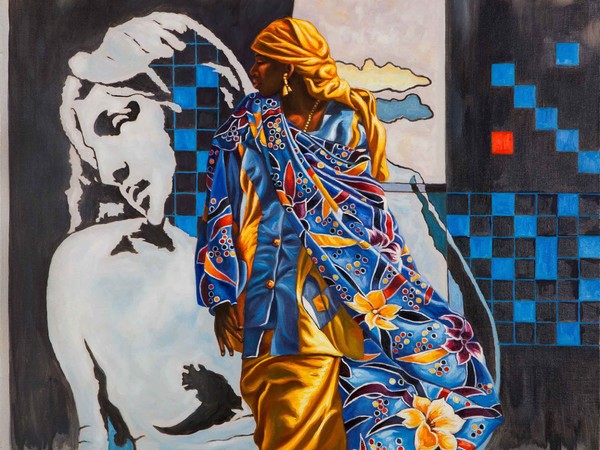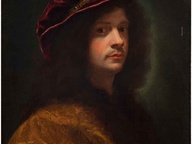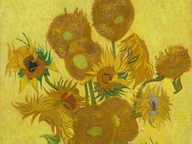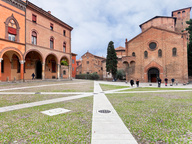Ali Hassoun. Crossover

Ali Hassoun, Da Tano da Michelangelo 2, olio su tela, cm 54x70
From 09 Febbraio 2017 to 08 Aprile 2017
Milan
Place: Studio Guastalla
Address: via Senato 24
Times: 10am-01pm / 03pm-07pm; closed on Monday and holidays
Telefono per informazioni: +39 02 780918
E-Mail info: info@guastalla.com
Official site: http://www.guastalla.com
Studio Guastalla presents CROSSOVER, around twenty recent works by Ali Hassoun, vibrantly colourful paintings and watercolours in which the Italo-Lebanese artist explores in depth the themes that have engrossed him for twenty years – nomadism, cultural contamination, multiple identities and the simultaneous co-existence of different worlds in one reality. Hassoun was born in Sidon and ended up in Milan twenty years ago after his studies and a long stay in Tuscany, split between Florence and Siena. The various identities that coalesce in him and his fascination with Africa, where some members of his family live, are refracted and recomposed in his works, as in a game of mirrors and allusions. Hassoun is constantly crossing a frontier in his pictures: his African women, his families in flight, his tightrope walkers standing out against a background of paintings that range from Andy Warhol to Capogrossi, from Picasso to Michelangelo. Hassoun's identity is moulded in a continuous shifting of time and place, of characters who are reflected, observing and acting, in a world that is not their own, leaping over temporal boundaries, blending and stratifying visual and cultural references.
As Martina Corgnati noted, in her critique accompanying the catalogue of the 2010 exhibition in the Palazzo Pubblico in Siena, “Ali Hassoun alla confluenza dei due mari" ("At the confluence of two seas”), it was by crossing the border between east and west, finding himself like a fish out of water, that Ali Hassoun was forced to question his identity, observing it as it were backlit, seen through filigree, to understand its core, in which diverse elements are interwoven and stratified. In this way the Arab identity has been able to mature, bringing to light not its more cliched, ideological or superficial components, but its deep-rooted structure. Hassoun's paintings are like images that recreate the narrative forms of Arabic literature: stories that allude to other stories in an endless game of Chinese boxes; the figure of the wanderer (the Alexandrian of the Hamadani's "Maqamat") who disguised himself, to reveal only in the end his narrative stratagems, pretending to consort with poets who actually lived in past eras.
In Hassoun's paintings, his phantasmagorical gallery of images taken from Western art are interlaced with the figures of modern day African women or people in constant migration, who lead us, just like the wanderer of the stories, into a multifaceted, polymorphous world. In his most recent works, icons disguised as other icons reveal hidden meaning by means of subtle irony – we have Van Gogh with Che Guevara's beret or a modern Judith with the face of Amy W inehouse decapitating Holofernes/Cattelan. The pop aesthetic of these crossovers and fusions is really nothing more than what we can see anywhere we are in the world: fast food signs next to Renaissance monuments, LED displays that suddenly light up at the gates of dusty far-off cities in the Far East, unruly crowds milling around, perhaps at a border they are seeking to cross, or perhaps even to attend a hyped-up cultural event, fake Italian cities recreated blemish-free in the American desert or savages who are in fact celebrities transported onto a reality island. In his latest works Hassoun appears to be alluding, with a smile, however, to this continuous sense of disorientation.
Ali Hassoun was born in Saida (Lebanon) in 1964. In 1982 he moved to Italy to continue his studies at the Accademia di Belle Arti in Florence. In 1992 he graduated from the city’s university with a degree in Architecture. He now lives and works in Milan. He has added Italian nationality to his Lebanese nationality, and has thus been able to fill in areas that were lacking in his own individual experience.
The most easily identifiable theme of his painting is travel, contributing different experiences and visions. Ali Hassoun’s works seem to act as a pole of attraction for various cultures, which merge to create a new, richer culture. In opposition to the clash of civilzations, Hassoun wants to highlight the idea of “humanity”; a universal and spiritual feature that is common to all people, and that always come first, before any political or religious division.
The artist becomes a sort of cultural translator, and different traditions can coexist in the perfectly balanced space of his colourful paintings. Islamic and African characters are all caught in a game of smart quotations and indirect exchanges between the main action and the background.
Elias Shaker, Faysal Sultan, Omar Calebrese, Mauro Civai, Gianni Giacopelli, Fabrizio Mezzedimi, Letizia Franchina, Luigi Zangheri, Jean Noel Schifano’, Alberto Fiz, Silvia Guastalla, Luca Beatrice, Alessandro Riva, Luca Pietro Vasta, Aldo Mondino, Chiara Guidi, Maurizio Sciaccaluga, Manuela Brevi, Ivan Quaroni, Gabriele Mandel Khan, Marina Moiana, Gianluca Marziani, Beatrice Buscaroli, Antonio d’Avossa, Murteza Fedan, Melih Gorgun, Chiara Canali, Mimmo di Marzio, Saleh Barakat, Gregory Buchakjian, Vittorio Sgarbi and Martina Corgnati have written about him.
Among his more important solo exhibitions: in 2010 Ali Hassoun alla confluenza dei due mari, curated by Martina Corgnati, at Siena's Palazzo Pubblico; in 2013 Il POPolo vuole, curated by Luca Beatrice, at Pontedera's Museo Piaggio; Lebanon Pavillion at Expo 2015.
SCARICA IL COMUNICATO IN PDF
COMMENTI

-
 Dal 31 gennaio 2024 al 04 maggio 2025
Fermo | Palazzo dei Priori
Dal 31 gennaio 2024 al 04 maggio 2025
Fermo | Palazzo dei Priori
-
 Dal 20 dicembre 2024 al 04 maggio 2025
Fermo | Palazzo dei Priori
Dal 20 dicembre 2024 al 04 maggio 2025
Fermo | Palazzo dei Priori
-
 Dal 20 dicembre 2024 al 04 maggio 2024
Gorizia | Palazzo Attems Petzenstein
Dal 20 dicembre 2024 al 04 maggio 2024
Gorizia | Palazzo Attems Petzenstein
-
 Dal 18 dicembre 2024 al 18 dicembre 2024
Venezia | Museo Correr
Dal 18 dicembre 2024 al 18 dicembre 2024
Venezia | Museo Correr
-
 Dal 14 dicembre 2024 al 02 marzo 2025
Palermo | Palazzo Abatellis
Dal 14 dicembre 2024 al 02 marzo 2025
Palermo | Palazzo Abatellis
-
 Dal 12 dicembre 2024 al 23 febbraio 2025
Roma | Palazzo Altemps
Dal 12 dicembre 2024 al 23 febbraio 2025
Roma | Palazzo Altemps


